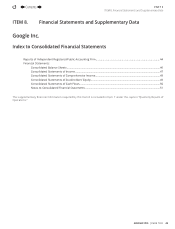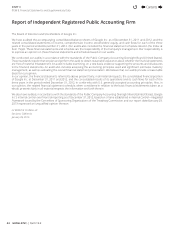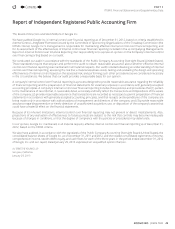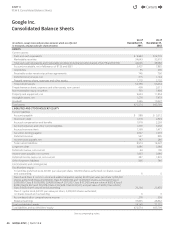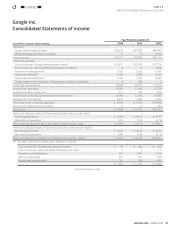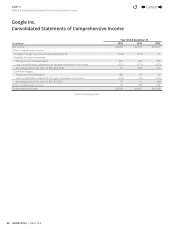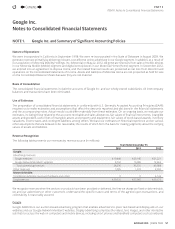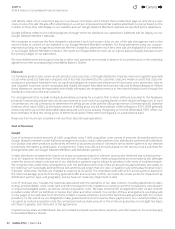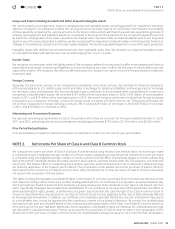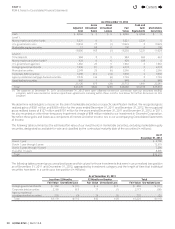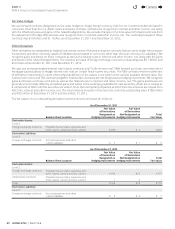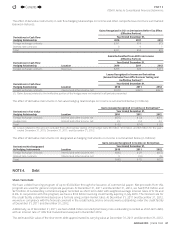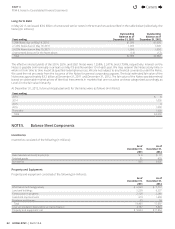Google 2012 Annual Report Download - page 59
Download and view the complete annual report
Please find page 59 of the 2012 Google annual report below. You can navigate through the pages in the report by either clicking on the pages listed below, or by using the keyword search tool below to find specific information within the annual report.
53GOOGLE INC. |Form10-K
PART II
ITEM8.Notes to Consolidated Financial Statements
Motorola
Cost of revenues from our Motorola business related to delivered hardware, including estimated warranty costs, are recognized
at the time of sale. Cost of revenues from Home are included in net loss from discontinued operations.
Stock-based Compensation
We have elected to use the Black-Scholes-Merton (BSM) option pricing model to determine the fair value of stock options on the
dates of grant. Restricted stock units (RSUs) are measured based on the fair market values of the underlying stock on the dates
of grant. Shares are issued on the vesting dates net of the minimum statutory tax withholding requirements to be paid by us on
behalf of our employees. As a result, the actual number of shares issued will be fewer than the actual number of RSUs outstanding.
Furthermore, we record the liability for withholding amounts to be paid by us as a reduction to additional paid-in capital when
paid. Also, we recognize stock-based compensation using the straight-line method.
We include as part of cash fl ows from fi nancing activities the benefi ts of tax deductions in excess of the tax-eff ected compensation
of the related stock-based awards for options exercised and RSUs vested during the period. During the years ended December31,
2010, December31, 2011, and December31, 2012, the amount of cash received from the exercise of stock options was $656million,
$621million, and $736million, and the total direct tax benefi t realized, including the excess tax benefi t, from stock-based award
activities was $355million, $451million, and $747million. We have elected to account for the indirect eff ects of stock-based
awards—primarily the research and development tax credit—through the Consolidated Statements of Income.
For the years ended December31, 2010, December31, 2011, and December31, 2012, we recognized stock-based compensation
expense and related tax benefi ts of $1,376million and $314million, $1,974million and $413million, and $2,649million and
$591million. Additionally, net loss from discontinued operations for the year ended December31, 2012 includes stock-based
compensation expense and related tax benefi ts of $43million and $11million.
Certain Risks and Concentrations
Our revenues are primarily derived from online advertising, the market for which is highly competitive and rapidly changing. In
addition, our revenues are generated from a multitude of vertical market segments in countries around the world. Signifi cant
changes in this industry or changes in customer buying or advertiser spending behavior could adversely aff ect our operating
results. In addition, for our Motorola business, nearly all of our Motorola products (other than some prototypes) are manufactured
outside the U.S., primarily in China, Taiwan and Brazil.
Financial instruments that potentially subject us to concentrations of credit risk consist principally of cash equivalents, marketable
securities, foreign exchange contracts, and accounts receivable. Cash equivalents and marketable securities consist primarily of time
deposits, money market and other funds, including cash collateral received related to our securities lending program, highly liquid
debt instruments of the U.S. government and its agencies, debt instruments issued by foreign governments and municipalities in
the U.S., corporate securities, mortgage-backed securities, and asset-backed securities. Foreign exchange contracts are transacted
with various fi nancial institutions with high credit standing. Accounts receivable are typically unsecured and are derived from
revenues earned from customers located around the world. In 2010, 2011, and 2012, we generated approximately 48%, 46%,
and 47% of our revenues from customers based in the U.S., with the majority of customers outside of the U.S. located in Europe
and Japan. Many of our Google Network Members are in the internet industry. We perform ongoing evaluations to determine
customer credit and we limit the amount of credit we extend, but generally we do not require collateral from our customers. We
maintain reserves for estimated credit losses and these losses have generally been within our expectations.
No individual customer or groups of a liated customers represented more than 10% of our revenues in 2010, 2011, and 2012.
Fair Value of Financial Instruments
Our fi nancial assets and fi nancial liabilities that include cash equivalents, marketable securities, and foreign currency and interest
rate derivative contracts are measured and recorded at fair value on a recurring basis. We measure certain other assets including
our non-marketable equity securities at fair value on a nonrecurring basis when they are deemed to be other-than-temporarily
impaired. Our other current fi nancial assets and our other current fi nancial liabilities have fair values that approximate their
carrying value and are therefore not recorded at fair value.
Cash, Cash Equivalents, and Marketable Securities
We invest our excess cash primarily in time deposits, money market and other funds, including cash collateral received related to
our securities lending program, highly liquid debt instruments of the U.S. government and its agencies, debt instruments issued by
foreign governments and municipalities in the U.S., corporate securities, mortgage-backed securities, and asset-backed securities.
We classify all highly liquid investments with stated maturities of three months or less from date of purchase as cash equivalents
and all highly liquid investments with stated maturities of greater than three months as marketable securities.
4
Contents
4


